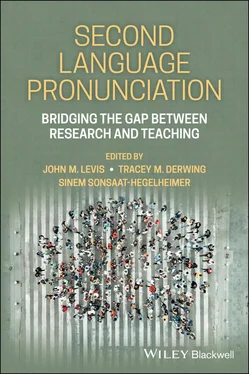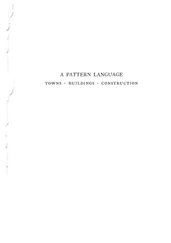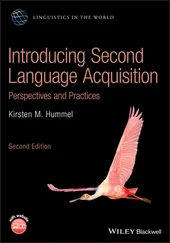Second Language Pronunciation
Здесь есть возможность читать онлайн «Second Language Pronunciation» — ознакомительный отрывок электронной книги совершенно бесплатно, а после прочтения отрывка купить полную версию. В некоторых случаях можно слушать аудио, скачать через торрент в формате fb2 и присутствует краткое содержание. Жанр: unrecognised, на английском языке. Описание произведения, (предисловие) а так же отзывы посетителей доступны на портале библиотеки ЛибКат.
- Название:Second Language Pronunciation
- Автор:
- Жанр:
- Год:неизвестен
- ISBN:нет данных
- Рейтинг книги:5 / 5. Голосов: 1
-
Избранное:Добавить в избранное
- Отзывы:
-
Ваша оценка:
- 100
- 1
- 2
- 3
- 4
- 5
Second Language Pronunciation: краткое содержание, описание и аннотация
Предлагаем к чтению аннотацию, описание, краткое содержание или предисловие (зависит от того, что написал сам автор книги «Second Language Pronunciation»). Если вы не нашли необходимую информацию о книге — напишите в комментариях, мы постараемся отыскать её.
Second Language Pronunciation: Bridging the Gap Between Research and Teaching
Second Language Pronunciation: Bridging the Gap Between Research and Teaching
Second Language Pronunciation — читать онлайн ознакомительный отрывок
Ниже представлен текст книги, разбитый по страницам. Система сохранения места последней прочитанной страницы, позволяет с удобством читать онлайн бесплатно книгу «Second Language Pronunciation», без необходимости каждый раз заново искать на чём Вы остановились. Поставьте закладку, и сможете в любой момент перейти на страницу, на которой закончили чтение.
Интервал:
Закладка:
6 Bigelow, M., & Vinogradov, P. (2011). Teaching adult second language learners who are emergent readers. Annual Review of Applied Linguistics, 31, 120–136. https://doi.org/10.1017/s0267190511000109
7 Bitterlin, G. (2018). Ventures 4 (3rd ed.). Cambridge University Press.
8 Burri, M. (2015). Student teachers’ cognitions about L2 pronunciation instruction: A case study. Australian Journal of Teacher Education, 40(10), 66–87. https://doi.org/10.14221/ajte.2015v40n10.5
9 Cauldwell, R. (2013). Phonology for listening. Speech in Action.
10 Celce-Murcia, M., Brinton, D., & Goodwin, J. (2010). Teaching pronunciation: A course book and reference guide. Cambridge University Press.
11 Conklin, L. (2011). What’s next? New Readers Press.
12 Dalton, C., & Seidlhofer, B. (1994). Pronunciation. Oxford University Press.
13 Darcy, I. (2018). Powerful and effective pronunciation instruction: How can we achieve it? CATESOL Journal, 30(1), 13–46.
14 Darcy, I., Rocca, B., & Hancock, Z. (2021). A window into the classroom: How teachers integrate pronunciation instruction. RELC Journal, 52(1), 110–127. https://doi.org/10.1177/0033688220964269
15 Derwing, T. (2008). Curriculum issues in teaching pronunciation to second language learners. In J. Hansen Edwards & M. Zampini (Eds.), Phonology and second language acquisition (pp. 347–369). John Benjamins. https://doi.org/10.1075/sibil.36.17der
16 Derwing, T., Munro, M., & Wiebe, G. (1998). Evidence in favor of a broad framework for pronunciation instruction. Language Learning, 48(3), 393–410. https://doi.org/10.1111/0023-8333.00047
17 Ehri, L. C., & Wilce, L. S. (1985). Movement into reading: Is the first stage of printed word learning visual or phonetic? Reading Research Quarterly, 20(2), 163–179. https://doi.org/10.2307/747753
18 Foote, J., Trofimovich, P., Collins, L., & Urzúa, F. (2016). Pronunciation teaching practices in communicative second language classes. The Language Learning Journal, 44(2), 181–196. https://doi.org/10.1080/09571736.2013.784345
19 French, L., Gagné, N., & Collins, L. (2020). Long-term effects of intensive instruction on fluency, comprehensibility and accentedness. Journal of Second Language Pronunciation, 6(3), 380–401. https://doi.org/10.1075/jslp.20026.fre
20 Gardner, S., Polyzoi, E., & Rampaul, Y. (1996). Individual variables, literacy history, and ESL progress among Kurdish and Bosnian immigrants. TESL Canada Journal, 14(1), 1–20.
21 Jones, T. (Ed.). (2016). Pronunciation in the classroom: The overlooked essential. TESOL Press.
22 Kurvers, J. (2007). Development of word recognition skills of adult L2 beginning readers. In N. R. Faux (Ed.), Low-educated adult second language and literacy acquisition proceedings of symposium (pp. 23–44). Literacy Institute at Virginia Commonwealth University.
23 Kurvers, J., Vallen, T., & van Hout, R. (2006). Discovering language: Metalinguistic awareness of adult illiterates. In I. van de Craats, J. Kurvers, & M. Young-Scholten (Eds.), Low-educated second language and literacy acquisition: Proceedings of the inaugural symposium (pp. 69–88). LOT Netherlands Graduate School of Linguistics.
24 Lee, J., Jang, J., & Plonsky, L. (2015). The effectiveness of second language pronunciation instruction: A meta-analysis. Applied Linguistics, 36(3), 345–366. https://doi.org/10.1093/applin/amu040
25 Liberman, I. Y., Shankweiler, D., Fischer, F. W., & Carter, B. (1974). Explicit syllable and phoneme segmentation in the young child. Journal of Experimental Child Psychology, 18(2), 201–212. https://doi.org/10.1016/0022-0965(74)90101-5
26 Levis, J. (2018). Intelligibility, oral communication, and the teaching of pronunciation. Cambridge University Press.
27 Levis, J., & Grant, L. (2003). Integrating pronunciation into ESL/EFL classrooms. TESOL Journal, 12(2), 13–19. https://doi.org/10.1002/j.1949-3533.2003.tb00125.x
28 Levis, J., & Muller Levis, G. (2018). Teaching high-value pronunciation features: Contrastive stress for intermediate learners. The CATESOL Journal, 30(1), 139–160.
29 Levis, J., & Sonsaat, S. (2016). Pronunciation materials. In M. Azarnoosh, M. Zeraatpishe, A. Favani, & H. R. Kargozari Issues in materials development (pp. 109–119). Sense Publishers. https://doi.org/10.1007/978-94-6300-432-9_10
30 Macdonald, S. (2002). Pronunciation-views and practices of reluctant teachers. Prospect, 17(3), 3–18.
31 Malicky, G., & Derwing, T. (1993). Literacy learning of adults in a bilingual ESL classroom. The Alberta Journal of Educational Research, 39(4), 393–406.
32 McGregor, A., & Reed, M. (2018). Integrating pronunciation into the English language curriculum: A framework for teachers. CATESOL Journal, 30(1), 69–94.
33 Morley, J. (1991). The pronunciation component in teaching English to speakers of other languages. TESOL Quarterly, 25(3), 481-520.
34 Munro, M., & Derwing, T. (2020). Collecting data in L2 pronunciation research. In O. Kang, S. Staples, K. Yaw, & K. Hirschi (Eds.), Proceedings of the 11th Pronunciation in Second Language Learning and Teaching Conference (pp. 8–18). ISSN 2380-9566. Northern Arizona University, September 2019. Iowa State University.
35 Murphy, J. (1991). Oral communication in TESOL: Integrating speaking, listening, and pronunciation. TESOL Quarterly, 25(1), 51–75. https://doi.org/10.2307/3587028
36 Pennington, M., & Rogerson-Revell, P. (2019). English pronunciation teaching and research: Contemporary perspectives. Palgrave Macmillan.
37 Sicola, L., & Darcy, I. (2015). Integrating pronunciation into the language classroom. In M. Reed & J. Levis (Eds.), The handbook of English pronunciation (pp. 471–489). Wiley Blackwell. https://doi.org/10.1002/9781118346952.ch26
38 Strube, S. (2009). What do teachers do? A look at the oral skills practice in the LESLLA classroom. In I. Van de Craats & J. Kurvers (Eds.), 2008 (pp. 46–62). LOT Netherlands Graduate School of Linguistics.
39 Tarone, E. (2010). Second language acquisition by low-literate learners: An under-studied population. Language Teaching, 43(1), 75–83. https://doi.org/10.1017/s0261444809005734
40 Tarone, E., Bigelow, M., & Hansen, K. (2009). Literacy and second language oracy. Oxford University Press.
41 Thomson, R., & Derwing, T. (2015). The effectiveness of L2 pronunciation instruction: A narrative review. Applied Linguistics, 36(3), 326–344. https://doi.org/10.1093/applin/amu076
42 U.S. Department of Education, Office of Career, Technical and Adult Education. (2016). Adult English language proficiency standards for adult education.
43 U.S. Department of Education, Office of Vocational and Adult Education. (2013). College and career readiness standards for adult education.
44 Walter, C. (2008). Phonology in second language reading: Not an optional extra. TESOL Quarterly, 42(3), 455–474. https://doi.org/10.1002/j.1545-7249.2008.tb00141.x
45 Zhang, R., & Yuan, Z. M. (2020). Examining the effects of explicit pronunciation instruction on the development of L2 pronunciation. Studies in Second Language Acquisition, 42(4), 905–918. https://doi.org/10.1017/s0272263120000121
Appendix: Doing a Basic Pronunciation Diagnostic
Our vignettes assume that teachers perform some type of pronunciation diagnostic or needs analysis for their students. There are many ways to do such a diagnosis, depending on the teacher and students (for more, see Morley, 1991). For those unaccustomed to diagnosing pronunciation systematically, we offer a simple approach that can be used even with students who have limited English. The diagnostic process has three steps: recording, listening, and evaluating. It is not necessary to notice every detail. A general picture of important pronunciation needs emerges from the process of diagnosis.
Читать дальшеИнтервал:
Закладка:
Похожие книги на «Second Language Pronunciation»
Представляем Вашему вниманию похожие книги на «Second Language Pronunciation» списком для выбора. Мы отобрали схожую по названию и смыслу литературу в надежде предоставить читателям больше вариантов отыскать новые, интересные, ещё непрочитанные произведения.
Обсуждение, отзывы о книге «Second Language Pronunciation» и просто собственные мнения читателей. Оставьте ваши комментарии, напишите, что Вы думаете о произведении, его смысле или главных героях. Укажите что конкретно понравилось, а что нет, и почему Вы так считаете.












